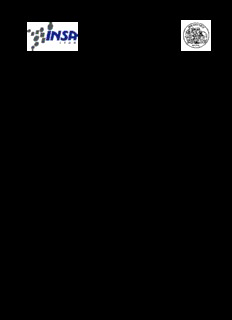Table Of ContentINSA DE LYON POLITECNICO DI MILANO
Laboratoire d’InfoRmatique en Images et Systèmes Dipartimento di Ingegneria Idraulica, Ambientale,
d’information infrastrutture viarie, Rilevamento
SEZIONE RILEVAMENTO
INSA de Lyon, Bâtiment Blaise Pascal Politecnico di Milano, pad. Sud
20, Avenue Albert Einstein Piazza Leonardo da Vinci, 32
F-69621 VILLEURBANNE Cedex (France) I-20133 MILANO (Italie)
ISAL *****
PhD
Jointly submitted at
the Institut National des Sciences Appliquées de Lyon
(Ecole Doctorale Informatique, Information pour la Société)
and the Politecnico di Milano
(Scuola di Dottorato in Geodesia e Geomatica)
By
Alice POZZOLI
DATA AND QUALITY METADATA FOR CONTINUOUS FIELDS:
TERRAINS AND PHOTOGRAMMETRY
___________________________________________________________________________
Supervisors: PhD committee:
Pr. Robert LAURINI, INSA de Lyon Pr. Norbert BARTELME, TU of Graz
Pr. Luigi MUSSIO, Politecnico di Milano Pr. Riccardo BARZAGHI, Politecnico di Milano
Pr. Alessandro CAROSIO, ETH Zürich
Reviewers: Pr. Christophe CLARAMUNT, Ec. Navale de Brest
Pr. Norbert BARTELME, TU of Graz Pr. Gianfranco FORLANI, Università di Parma
Pr. Alessandro CAROSIO, ETH Zürich Pr. Pierre GRUSSENMEYER, INSA de Strasbourg
Pr. Christophe CLARAMUNT, Ecole Navale de Brest Pr. Robert LAURINI, INSA de Lyon
Pr. Pierre GRUSSENMEYER, INSA de Strasbourg Pr. Luigi MUSSIO, Politecnico di Milano
I
DIIAR – Politecnico di Milano I LIRIS – INSA de Lyon
[email protected] [email protected]
CO-SUPERVISION AGREEMENT
Index
INDEX
CO-SUPERVISION AGREEMENT II
INDEX VI
1. RESUME ETENDU 10
1.1. INTRODUCTION......................................................................................10
1.1.1. Etat de l’art.................................................................................. 10
PARTIE I. DONNEES GEOMATIQUES ET PHOTOGRAMMETRIQUES...................................11
1.2. CONCEPTS D’INFORMATION GÉOGRAPHIQUE................................................11
1.2.1. Données Géographiques et Interopérabilité....................................... 11
1.2.2. Standardisation et Information Géographique.................................... 12
1.2.3. XML (eXtensible Markup Language) et ses extensions......................... 13
1.2.4. Standard ISO et GML..................................................................... 16
1.2.5. Organisation des Données Géographiques......................................... 16
1.2.6. Description des géo-données........................................................... 19
1.2.7. Conclusion de la Partie II................................................................ 21
PARTIE II. ACQUISITION ET TRAITEMENT DES DONNEES............................................21
1.3. SEQUENCES MULTIPLE DE SCENES EN STEREO AVEC LA PHOTOGRAMMETRIE..........21
1.3.1. Formation du Modèle et Reconstruction de l’Objet.............................. 21
1.3.2. Orientation Relative de trois images avec une recherche exhaustive
des valeurs (des paramètres) approximées..................................... 22
1.3.3. Formation du Modèle...................................................................... 23
1.3.4. Procédure à trois images : Concaténation des Modèles........................ 25
1.3.5. Simulation.................................................................................... 27
1.3.6. Conclusions de la Partie II .............................................................. 27
PARTIE III. UN EXEMPLE EN PHOTOGRAMMETRIE ET DEVELOPPEMENTS FUTURS...............28
1.4. UNE APPLICATION..................................................................................28
1.4.1. Le Model Hydraulique et ses problèmes ............................................ 28
1.4.2. Le Relief....................................................................................... 30
1.4.3. Gestion des données photogramètriques........................................... 36
1.4.4. Champs d’applications et applications futures.................................... 39
1.4.5. Conclusions de la Partie III ............................................................. 39
DIIAR – Politecnico di Milano VI LIRIS – INSA de Lyon
[email protected] [email protected]
1.5. CONCLUSIONS.......................................................................................39
2. INTRODUCTION 41
2.1. LITERATURE REVIEW ..............................................................................42
2.1.1. Photogrammetry ........................................................................... 42
2.1.2. Geo-data...................................................................................... 44
2.1.3. XML for Geographic Data................................................................ 45
2.2. OBJECTIVE AND CONTRIBUTION................................................................46
2.3. OVERVIEW AND ORGANIZATION................................................................47
PART I. THE GEO-DATA 48
3. GEO-INFORMATION CONCEPTS 49
3.1. GEOGRAPHIC DATA AND INTEROPERABILITY................................................49
3.2. STANDARDIZATION OF GEOGRAPHIC INFORMATION.......................................50
3.2.1. Committees, Organizations and Consortia......................................... 50
3.2.2. ISO norms for Data Transfer: actual status....................................... 50
3.2.3. XML (eXtensible Markup Language) and its Extensions........................ 51
3.2.4. How to choose a Language for Geo-data........................................... 53
3.3. ISO STANDARDS AND GML......................................................................55
3.4. ORGANIZATION OF GEOGRAPHIC DATA.......................................................56
3.4.1. Conceptual Schema....................................................................... 57
3.4.2. Model-driven Approach (MDA)......................................................... 59
3.5. DESCRIBING GEOGRAPHIC DATA...............................................................61
3.5.1. Quality of Data and Metadata.......................................................... 62
3.5.2. Metadata Specifications.................................................................. 63
3.6. PART I CONCLUSIONS.............................................................................64
PART II. DATA ACQUISITION AND PROCESSING 65
4. STEREO MULTIPLE SCENE SEQUENCES BY PHOTOGRAMMETRY 66
4.1. MODEL FORMATION AND OBJECT RECONSTRUCTION.......................................66
4.1.1. Three-image orientation through exhaustive research......................... 66
4.2. FROM IMAGES TO OBJECT VIA MODEL.........................................................66
4.2.1. Projection transformation ............................................................... 68
DIIAR – Politecnico di Milano VII LIRIS – INSA de Lyon
[email protected] [email protected]
4.3. MODEL FORMATION................................................................................68
4.3.1. Relative Orientation Parameters....................................................... 68
4.3.2. Exhaustive Research...................................................................... 69
4.3.3. Model Coordinates......................................................................... 70
4.3.4. Critical Cylinder............................................................................. 72
4.4. 3-IMAGE PROCEDURE..............................................................................73
4.4.1. Bridging the models....................................................................... 73
4.5. OBJECT RECONSTRUCTION........................................................................74
4.5.1. A Linear Solution by Rodriguez Matrix............................................... 74
4.5.2. Absolute Orientation with 3-image procedure .................................... 75
4.6. SIMULATION.........................................................................................76
4.7. PART II CONCLUSIONS ...........................................................................77
PART III. A PHOTOGRAMMETRIC EXAMPLE AND FURTHER
DEVELOPMENT 81
5. AN APPLICATION 82
5.1. THE HYDRAULIC MODEL AND ITS PROBLEMS ................................................82
5.1.1. Modeling...................................................................................... 83
5.1.2. Characteristics and Simulation Modeling ........................................... 84
5.1.3. Results......................................................................................... 85
5.2. THE SURVEY .........................................................................................85
5.2.1. Static Survey................................................................................ 86
5.2.2. Dynamic Survey............................................................................ 87
5.3. PHOTOGRAMMETRIC DATA MANAGEMENT ....................................................96
5.3.1. Conceptual Data Model................................................................... 97
5.3.2. The Transfer Format Automatically Generated from a Conceptual
Model (GML Schema and GML/XML file).......................................... 99
5.3.3. Application Field...........................................................................104
5.4. PART III CONCLUSIONS........................................................................104
6. CONCLUSION 107
6.1. SUMMARY OF THE ACHIEVEMENTS............................................................107
6.2. FUTURE WORKS...................................................................................108
7. APPENDIX 110
DIIAR – Politecnico di Milano VIII LIRIS – INSA de Lyon
[email protected] [email protected]
A. SPATIO-TEMPORAL MODELING OF SCENE SEQUENCES: AN
INTEGRATED APPROACH 110
A.1. INTERPOLATION TECHNIQUES.................................................................110
A.1.1. The generalized Least Squares.......................................................112
A.1.2. Covariance estimation...................................................................116
A.1.3. Finite element interpolation............................................................119
B. TOPOLOGICAL MODELING 122
B.1. ALTERNATIVE APPROACH.......................................................................122
B.1.1. Object modeling...........................................................................122
B.1.2. Relations among the object elements..............................................126
B.1.3. Linear, Planar and Spatial Symmetries.............................................137
B.2. CLASSICAL APPROACH...........................................................................146
B.2.1. From Reality to the Model..............................................................146
B.3. COMPARISON AND CONCLUSION..............................................................152
C. INTERLIS FILE 154
D. GML SCHEMA (DEM_MODEL.XSD) 157
REFERENCES 168
WEB ........................................................................................................168
BOOKS ........................................................................................................169
PUBLICATIONS...............................................................................................171
INTERNAL REFERENCES ....................................................................................179
ABSTRACT 184
RESUME 186
RIASSUNTO 188
DIIAR – Politecnico di Milano IX LIRIS – INSA de Lyon
[email protected] [email protected]
Description:Index. DIIAR – Politecnico di Milano. VI. LIRIS – INSA de Lyon . 28. 1.4.1. Le Model Hydraulique et ses problèmes . sauvegardées automatiquement en un format standard, XML l'écriture des programmes de traitement des documents XML doit être aisée. fois vérifiée la justesse syntaxique.

